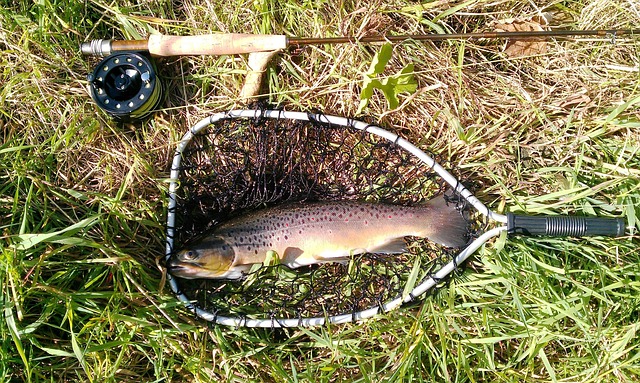A 3-wt fly rod is a lightweight fishing rod designed for delicate presentations and targeting small fish species. When it comes to choosing the best length for a 3 wt fly rod, there are a number of factors to consider, including casting distance, accuracy, fishing environment, personal preference, and skill level. The length of your fly rod can have a significant impact on your fishing experience, which is why it’s important to select the right one.
In this post, I’ll discuss the pros and cons of different lengths for 3 wt fly rods and provide tips on how to choose the best length for you.
Factors to Consider When Choosing the Best Length for a 3 wt Fly Rod
When choosing the best length for a 3 wt fly rod, there are several factors to consider:
- Casting distance: The length of your fly rod will affect how far you can cast. Longer rods typically provide greater casting distance, while shorter rods are better suited for shorter casts. Consider the fishing environment and the distance you’ll need to cast when choosing a rod length.
- Accuracy: The length of your fly rod can also affect your casting accuracy. Longer rods may provide more leverage and a smoother casting stroke, but they can also be more difficult to control. Shorter rods may be easier to control and more accurate, but they may not cast as far.
- Fishing environment: The environment you’ll be fishing in can also play a role in selecting the best length for your 3 wt fly rod. For example, if you’ll be fishing in tight streams or small creeks, a shorter rod may be more appropriate. If you’ll be fishing in larger bodies of water or open spaces, a longer rod may be better.
- Personal preference: Your personal preferences and comfort level are important considerations when selecting a fly rod. Some anglers prefer longer rods for their casting distance, while others prefer shorter rods for their accuracy and control.
- Skill level: Your skill level as an angler can also play a role in choosing the best length for your 3 wt fly rod. Beginners may find shorter rods easier to control, while more experienced anglers may prefer longer rods for their casting distance and leverage.
Pros and Cons of Different Lengths for 3 wt Fly Rods
When it comes to choosing the length of your 3 wt fly rod, there are several options to consider. Each length has its own advantages and disadvantages, which we’ll discuss below.
6-foot rods
Pros: – Good for small streams and creeks with tight spaces and obstacles – Easier to control and more accurate in shorter casts – Lightweight and easy to pack
Cons: – Limited casting distance – May not be suitable for larger bodies of water
7-foot rods
Pros: – Good compromise between control and casting distance – Suitable for small to medium-sized streams and rivers – Easy to pack and transport
Cons: – May not be ideal for long casts or larger bodies of water
8-foot rods
Pros: – Good for larger bodies of water – Increased casting distance – Good leverage for fighting larger fish
Cons: – Less control and accuracy than shorter rods – More difficult to use in tight spaces
9-foot rods
Pros: – Maximum casting distance – Good for larger rivers, lakes, and ponds – Can handle larger fish
Cons: – Less control and accuracy than shorter rods – May be too long for smaller streams and creeks
It’s important to note that these pros and cons are general guidelines and may vary depending on the specific model and manufacturer of the rod.
Choosing the Best Length for You
Choosing the best length for your 3 wt fly rod is a personal decision that should take into account your fishing style and environment, as well as your personal preferences and skill level. Here are some tips to help you choose the best length for you:
- Identify your fishing style and environment: Consider the type of fishing you’ll be doing and the environment you’ll be fishing in. If you’ll be fishing in tight spaces or small creeks, a shorter rod may be more appropriate. If you’ll be fishing in larger bodies of water, a longer rod may be better.
- Consider your skill level: If you’re a beginner, a shorter rod may be easier to control and more accurate. If you’re an experienced angler, you may prefer a longer rod for its increased casting distance and leverage.
- Try before you buy: If possible, try out different lengths of 3 wt fly rods to see which one feels most comfortable and effective for you. This can be done at a fly shop or by renting or borrowing different rods from friends.
Ultimately, the best length for your 3 wt fly rod will depend on your individual needs and preferences. It’s important to choose a rod that feels comfortable and effective for the type of fishing you’ll be doing.
Conclusion
In conclusion, choosing the best length for a 3 wt fly rod depends on several factors, including casting distance, accuracy, fishing environment, personal preference, and skill level. The length of your fly rod can have a significant impact on your fishing experience, which is why it’s important to select the right one. Each length of 3 wt fly rod has its own advantages and disadvantages, and it’s important to choose the one that best fits your needs and preferences. By considering your fishing style and environment, skill level, and trying out different lengths before you buy, you can choose the best length for your 3 wt fly rod and have a more enjoyable and successful fishing experience.
Learn more about the 3-weight switch rod by clicking on this link.










